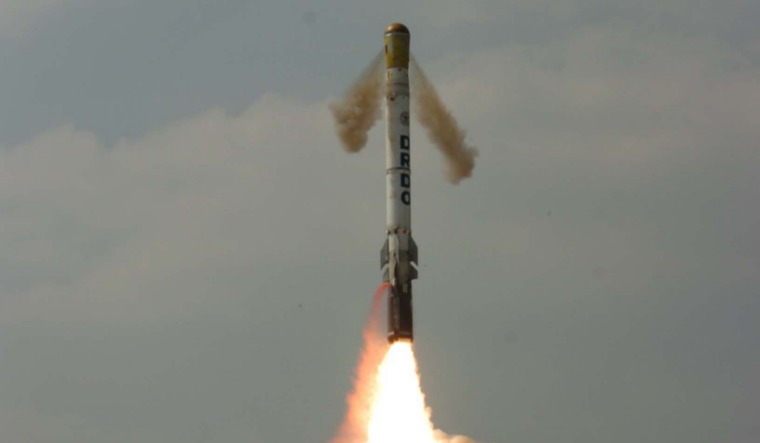India tests HYPERSONIC SHAURYA MISSILE : land version of K15 Submarine launched missile

The surface-to-surface medium range Shaurya missile can reach speeds of 7.5 Mach – seven and half times the speed of sound. The cruise missile can hit targets 750 kilometres away – its range increased from the existing 290 kilometres
The shaurya missile was launched last Saturday. It was tracked and monitored through an integrated system of sophisticated radars, electro-optical tracking instruments and a chain of telemetry stations positioned in different points, It performed a manoeuvre in the terminal phase and hit the impact point. It was the first user-specific trial of the missile that is a land variant of submarine-launched ballistic missile K-15.
India has thus successfully test-fired a new land version of the nuclear-capable hypersonic missile K15, with a range of 750 kilometres from a defence facility off the Odisha coast. The launch is the latest in a string of recent weapons tests amid military tensions with China in the Ladakh sector.
The launch came three days after India test-fired an extended-range BrahMos surface-to-surface supersonic cruise missile from the Integrated Test Range at Balasore in Odisha. The cruise missile can now hit targets 800 kilometres away – its range was earlier increased from the existing 290 kilometres to 400km.
Describing the trial as successful, the sources said that the state-of-the-art missile performed a manoeuvre in the closing stages of its flight and hit the impact point in the Bay of Bengal with precision and accuracy.
The surface-to-surface short range Shaurya missile, that can reach speeds of 7.5 Mach (seven and half times the speed of sound), blasted off from a canister from the Abdul Kalam Island test range off Dhamra at about 12.10 pm. Though there was no official word from the government on the successful launch.
A gas generator at the bottom of the canister pushed the missile out it. The gas generator, located at the bottom of the canister, fires for about a second and a half. It produces high pressure gas, which expands and ejects the missile from the tube. The missile has six motors; the first one is the motor in the gas generator. The centrepiece of a host of new technologies incorporated in Shaurya is its ring laser gyroscope and accelerometer. Its first stage ignited then and fell off. The second stage went into action after this, a Defence Research and Development Organisation (DRDO) official said. During the test flight, the missile was tracked by various telemetry stations and radars and performed well, he said.
The K15 missile was designed specifically to be fired from submarines. A top DRDO scientist has confirmed this and further said that after taking off and reaching a height of about 50 km, the missile starts flying like a hypersonic cruise missile. Once it reaches the target area it manoeuvres towards the target before striking with an accuracy of 20 to 30 m within the target area.
The missile, equipped with multiple advanced computing technology and high accuracy navigation, efficient propulsion, sophisticated control and guidance systems, successfully followed its target in the Bay of Bengal, Defence Research and Development Organisation (DRDO) officials said.
“This kind of demonstration of capability/power is extremely important to give a loud message to another nuclear-powered country that they should not take us for granted. This will bring in inherent dissuasion that will further discourage our adversaries from using nuclear weapons (against us),” said former Northern Army commander Lieutenant General BS Jaswal (retd).
The two-stage missile that uses solid propellants can deceive enemy radars after launch, the officials said. The 10 metre-long missile – weighing 6.2 tonne – can carry both nuclear and conventional warheads weighing up to 1,000 kilograms.
The DRDO officials said once launched, Shaurya would be difficult to track by radars as the window for detection, tracking and interception is only 400 seconds. Like the BrahMos supersonic cruise missile, Shaurya can be stored in a composite canister, making it easier to handle and transport.
Like a ballistic missile, it is powered by solid fuel, but can guide itself up to the target like a cruise missile, the officials added.
On September 7, India took the first steps towards developing a new class of ultra-modern weapons that can travel six times faster than the speed of sound (Mach 6) and penetrate any missile defence, with the DRDO carrying out a successful flight test of the hypersonic technology demonstrator vehicle (HSTDV) for the first time from a launch facility off the Odisha coast.
Only the United States, Russia and China have developed technologies to field fast-manoeuvring hypersonic missiles that fly at lower altitudes and are extremely hard to track and intercept.
India could develop hypersonic cruise missiles powered by air-breathing scramjet engines in about four years.




